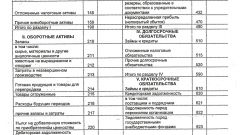You will need
- The balance sheet
Instruction
1
For determining the liquidity of the enterprises used the data from the financial statements. Liquidity is nominal, the company's ability to repay the current debt only at the expense of circulating assets. Distinguished current, quick and absolute liquidity.
2
Current liquidity ratio (coverage ratio) is the ratio of current assets OA, net long-term receivables DZ and debt of the company founders by contribution to the share capital of ZUK current liabilities TA(current liabilities). For calculation use the following formula: K1 = (OA – DZ – Zuke)/TA, where K1 is the current ratio. Take data from the accounting balance sheet, form 1: K1 = (строки290 - 230 - 220)/(строки690 - 650 - 640)
3
It is believed that the current liquidity is within normal limits, if the indicator value varies in the range from 1.5 to 2.5 (depending on the industry of the enterprise). If the ratio is less than 1, the financial capacity of the company is unstable, there is a high financial risk.
4
Quick liquidity - the possibility of early repayment of debts in case of emergency due to the highly liquid current assets (short term financial investments, cash, etc.). Mathematically it is the ratio of current assets with high liquidity THAT less inventories Inventories current liabilities TP. Use the formula: K2 = (TA – EMF)/TP.
K2 = (строки240 + 250 + 260) / (строки690 - 650 - 640).
K2 = (строки240 + 250 + 260) / (строки690 - 650 - 640).
5
Absolute liquidity - redemption due to the only available cash or equivalent assets. Coefficient equal to the ratio of the amount of money the DS and short-term investments KV current liabilities TP. Use the formula K3 = (LB + KV)/TP. K3 = (строки260 + 250) / (строки690 - 650 - 640). It is believed that the value is in the normal range if it is greater than 0.2, i.e. 20%.
Useful advice
There are computer programs to calculate and analyze the values of indicators of liquidity, for example, 1C.






